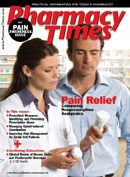Publication
Article
Pharmacy Times
Improving Pain Management for the Sickle Cell Patient
Author(s):
Ms. Terrie is a clinical pharmacy writer based in Haymarket, Virginia.
Sickle cell disease (SCD) is one of the most prevalent autosomal, recessive genetic disorders in the United States and is defined as a group of inherited hematologic disorders in which hemoglobin S is the dominant hemoglobin.1-4 Chronic hemolytic anemia and vaso-occlusion are considered to be prime pathophysiologic features and pain a common symptom.1-3
This disorder affects millions of individuals worldwide and an estimated 90,000 individuals in the United States, primarily individuals of African American descent, as well as those from regions of South America, the Caribbean, and Central America and individuals of middle eastern ancestry or from the Mediterranean region.1-4 Sickle cell anemia occurs in 1 of every 500 African American births, and an estimated 1 of every 12 (2 million African Americans) have the sickle cell trait.2-4
SCD is characterized by both acute and chronic episodes of pain. Recurring episodes of acute, severe pain are the disease’s hallmark characteristics.1 The majority of sickle cell patients experience painful episodes, also referred to as a sickle cell crisis, which can last from hours to days. Some patients may experience one pain episode every few years, whereas others have several episodes annually. These episodes can be so severe that patients may need to be admitted to the hospital for pain management. Pain crisis is considered to be the primary reason for visits to the emergency department (ED) or hospital admissions.1-5
Episodes of pain vary in frequency and intensity from patient to patient and can be classified as acute, chronic, or mixed, according to temporal characteristics.1,6 Acute pain in patients with SCD is caused by ischemic tissue injury, which is due to the occlusion of microvascular beds by sickled erythrocytes during an acute crisis.1,6 Chronic pain stems from destruction of bones, joints, and visceral organs as a result of recurrent crises.1,6 Acute pain episodes can occur spontaneously and be triggered by extreme temperature changes, changes in altitude, physical and emotional stress, an illness, the presence of infections, and dehydration.7-9
Other factors that may trigger painful episodes include cold climates, menstruation, and fatigue.8 Less than 50% of patients can identify the precipitating factor. The most common sites for pain are lower back, thigh, hip, knee, abdomen, and chest.8 Sources of chronic sickle cell pain include aseptic necrosis, leg ulcerations, and bone infections.8
Unfortunately, the acute and chronic pain associated with SCD is commonly undertreated or inappropriately managed; therefore, the American Pain Society developed a clinical practice guideline to provide health care professionals with evidence-based recommendations that can aid in improving pain management.10 Initially, pain management should be aimed at providing rapid and adequate pain control and identifying the cause of pain.1
Preventive Therapy
For several years, clinicians and researchers observed that many chemotherapeutic agents increased fetal hemoglobin levels.4 In the 1980s, clinical trials were initiated to determine if hydroxyurea therapy could increase fetal hemoglobin levels in adults with SCD and reduce vaso-occlusive problems. 4 Hydroxyurea has been used for many years to treat myeloproliferative disorders, such as chronic myelogenous leukemia, and is classified as an antimetabolite agent that exhibits antiviral activity. Hydroxyurea has shown favorable effects in reducing the frequency of painful episodes and acute chest syndrome in adult sickle cell patients.1,3,11
In 1998, the FDA approved hydroxyurea for use in symptomatic adult sickle cell patients, because hydroxyurea was shown to increase the production of hemoglobin F, reduce endothelial adhesion of sickle cells, and improve cell hydration.4 This agent is the first and only approved prophylactic agent for SCD. It is indicated to reduce the frequency of painful crisis and to reduce the need for blood transfusions in adult patients with sickle cell anemia with recurrent moderate-to-severe painful crises (generally at least 3 during the preceding 12 months).1,4,12 The use of hydroxyurea in patients <18 years of age remains an off-label use, although many sickle cell centers use hydroxyurea to treat pediatric patients with severe disease.4,13
Fetal hemoglobin levels begin to decrease in sickle cell patients around 6 months of age; thus, various studies are investigating the use of hydroxyurea in the pediatric population.4 Additional information on clinical trials regarding hydroxyurea and children can be found at www.clinicaltrials.gov/ct2/ results?term=hydroxyurea.
Although hydroxyurea is not a cure for sickle cell anemia, this agent has been shown to decrease the number of hospitalizations, vaso-occlusive complications, and pulmonary tissue damage from acute chest syndromes by half, thus making SCD crisis less intense.1,4,14 Known pharmacologic effects of hydroxyurea that may contribute to its beneficial effects include increasing hemoglobin F levels in red blood cells (RBCs), decreasing neutrophils, increasing the water content of RBCs, increasing deformability of sickled cells, and changing the adhesion of RBCs to endothelium.11
Hydroxyurea is pregnancy category D, and its use is contraindicated in pregnancy. It is also contraindicated in severe anemia, hypersensitivity to any component of the formulation, and severe bone marrow suppression.11,15,16 The drug is mutagenic and clastogenic, and long-term use could result in secondary leukemia.11,15,16
For the palliative treatment of SCD with recurrent moderate-to-severe painful crises in adults, the recommended initial dosage of hydroxyurea is 15 mg/kg daily based on patient weight and is administered as a single dose.11,16 Some patients have experienced severe or life-threatening myelosuppression requiring interruption of therapy and subsequent dosage reduction.11-17
Hydroxyurea is readily absorbed after oral administration, and peak plasma levels are achieved within 1 to 4 hours after administration.15,16 During counseling, patients should be reminded to exercise caution when handling hydroxyurea and that the powder should not come in contact with the skin or mucous membranes. Patients should wear disposable gloves when possible to decrease the risk of skin exposure and should wash hands before and after contact.11,17 If the contents of the capsule are spilled, the powder should be wiped up immediately with a damp disposable towel and discarded in an appropriate container (eg, a sealed plastic bag). A clinician should be contacted for instructions on how to discard unused or expired hydroxyurea capsules.11,17
The primary adverse effect of hydroxyurea therapy is myelosuppression of blood cells—most importantly, neutrophils and thrombocytes.4,11,16 Patients at risk for infection and bleeding problems may be at risk for severe neutropenia and thrombocytopenia. Other reported adverse effects are gastrointestinal upset, nausea, rash, increases in creatinine levels, and nail and skin hyperpigmentation.15,16 It is strongly recommended that patients have their blood counts routinely monitored by a hematologist, and dosage should be adjusted accordingly when necessary.
Pain Management
During a sickle cell crisis, analgesics are often required, not only for acute severe vaso-occlusive pain but also for chronic intermittent or persistent pain.1,18 The primary goal of pain management is providing the patient with adequate relief. According to the American Pain Society guidelines, the use of analgesics should be individualized per patient and tailored according to the level of pain.1
Pharmacologic management of sickle cell pain entails the use of 3 major drug classes, which include nonopioids, opioids, and adjuvants.1,18,19 To improve analgesia, manage other symptoms associated with sickle cell pain, or for the treatment of adverse effects, adjuvant treatments (eg, antihistamines, phenothiazones, antiemetics, laxatives, benzodiazepines) are often used.1,18
For mild-to-moderate pain, acetaminophen and nonprescription nonsteroidal anti-inflammatory drugs (NSAIDs) are often used.1 Patients with SCD may have varying degrees of hepatic impairment, and thus, acetaminophen may be contraindicated. NSAIDs are contraindicated in patients with gastritis, peptic ulcers, coagulation disorders, and renal failure.1
Moderate-to-severe pain is often treated with opioids with or without NSAIDs or other adjuvant medications.1 Opioid maintenance therapy for patients with SCD should be considered only after all other reasonable attempts to achieve analgesia with nonopioids have been made.1 Morphine is considered the drug of choice for the treatment of acute sickle cell pain crisis; however, pharmacokinetics and dosing vary among patients.8 Other opioids commonly used include hydromorphone, codeine, hydrocodone, oxycodone, methadone, and fentanyl.1,8 Whereas meperidine is the opioid most commonly used in EDs, its use for acute or chronic pain is often discouraged due to the risk of seizures.1,8 Many patients with SCD may be at greater risk of seizures due to reduced renal function, high meperidine dosages, and altered meperidine pharmacokinetics. 1,8,19
The adverse effects associated with opioid analgesics include sedation, hives, nausea, vomiting, constipation, and respiratory depression.1,8,19
Conclusion
Uncontrolled pain continues to be a problem for patients with SCD, and initial management should be aimed at providing the patient with rapid and adequate pain relief. Effective management of pain in SCD can pose various challenges; pain management should be aggressive and enable patients to function in their day-to-day routine. Therapy should be individualized based on the severity and frequency of pain, as well as the patient’s current medical, medication, and allergy history.
Newsletter
Stay informed on drug updates, treatment guidelines, and pharmacy practice trends—subscribe to Pharmacy Times for weekly clinical insights.







